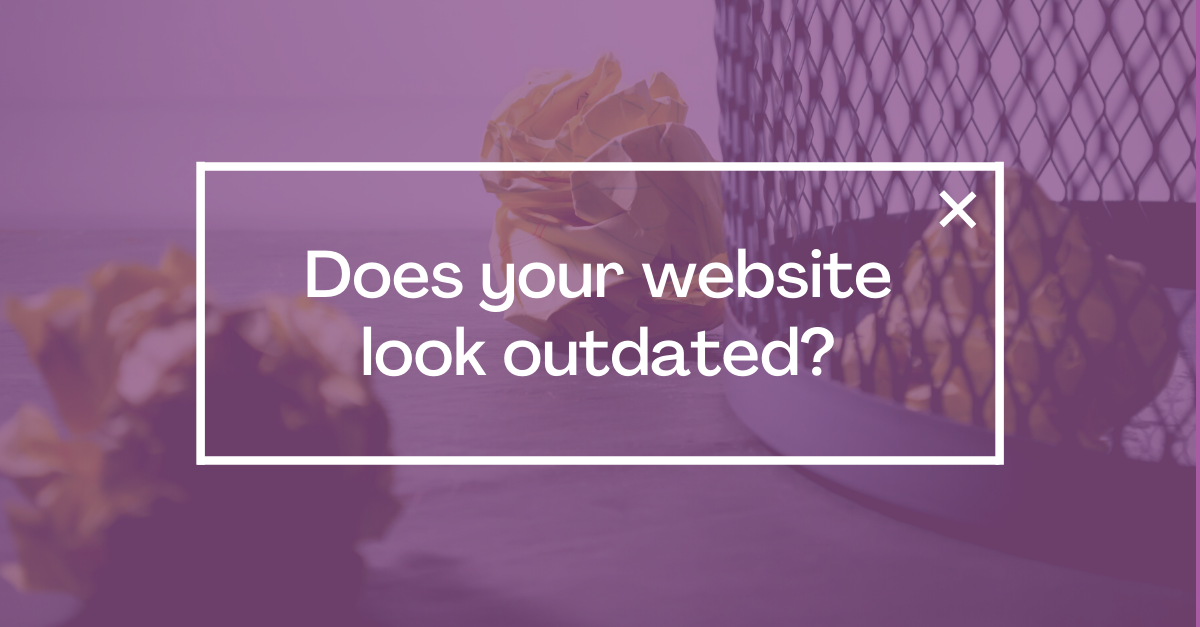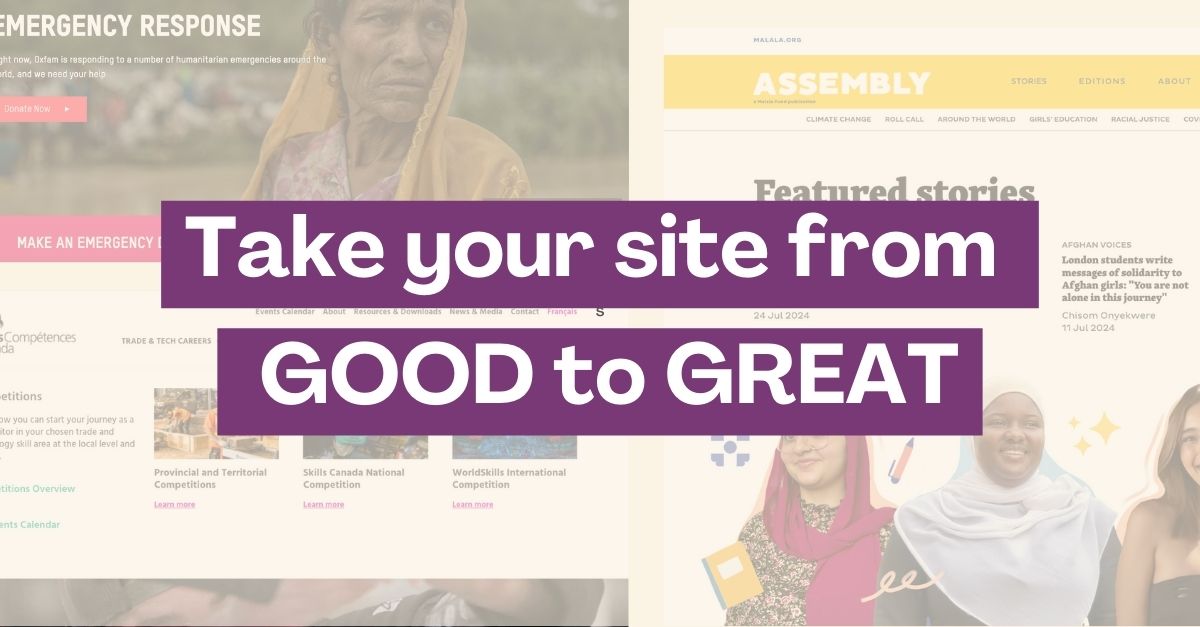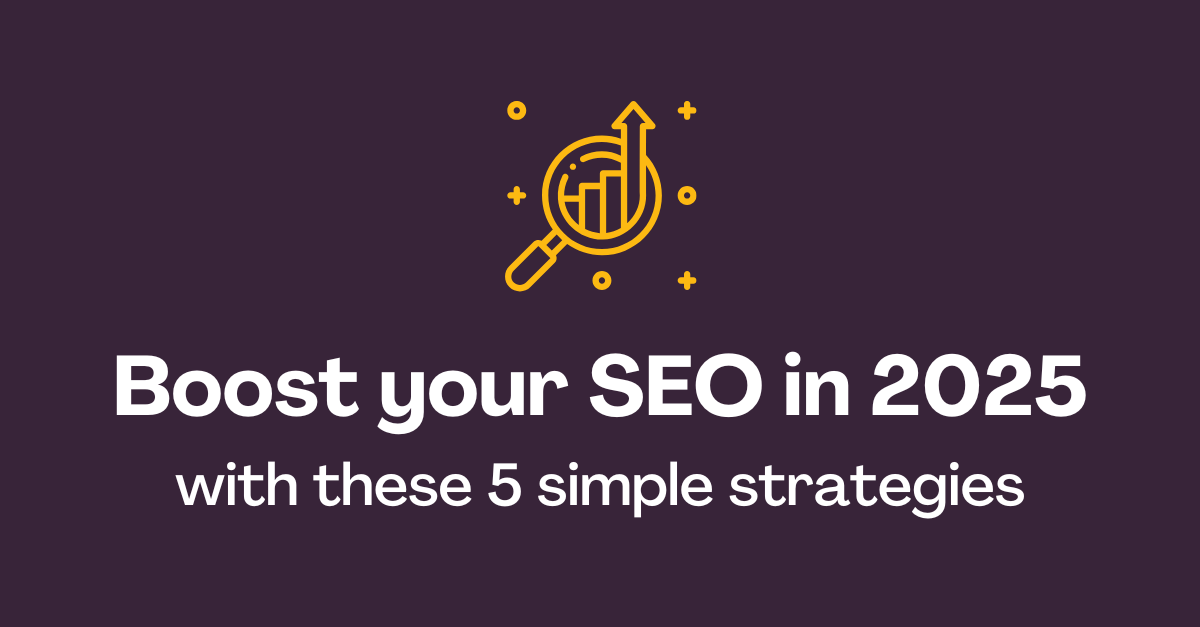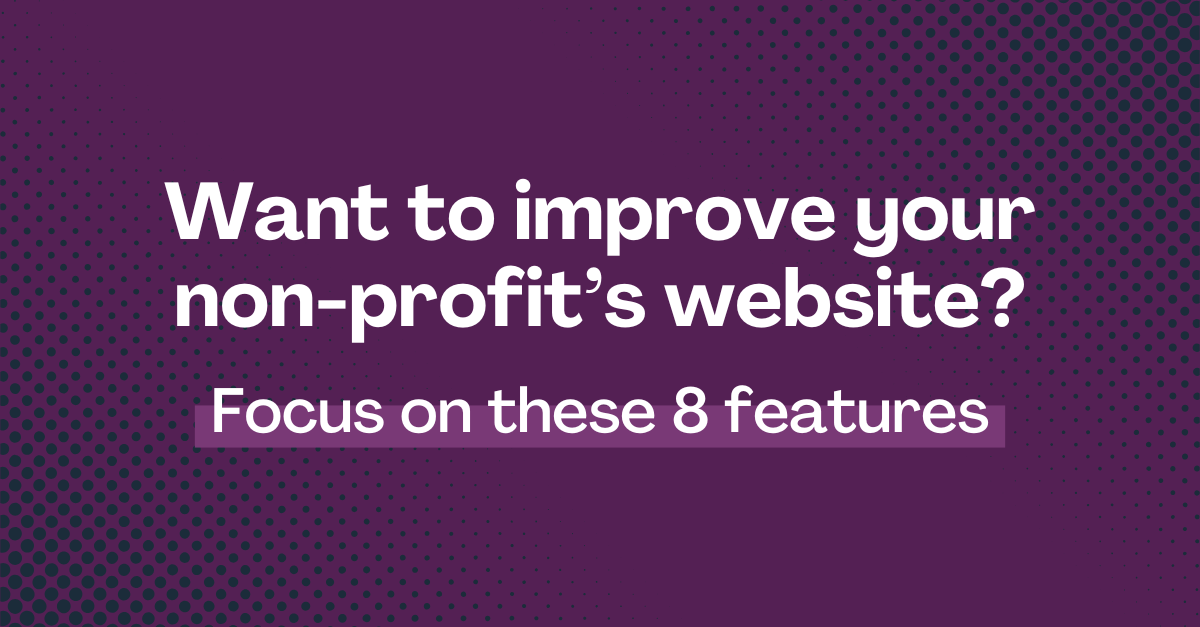"*" indicates required fields
Social Media Advertising 101 for Non-Profits: A Guide to Amplifying Your Mission
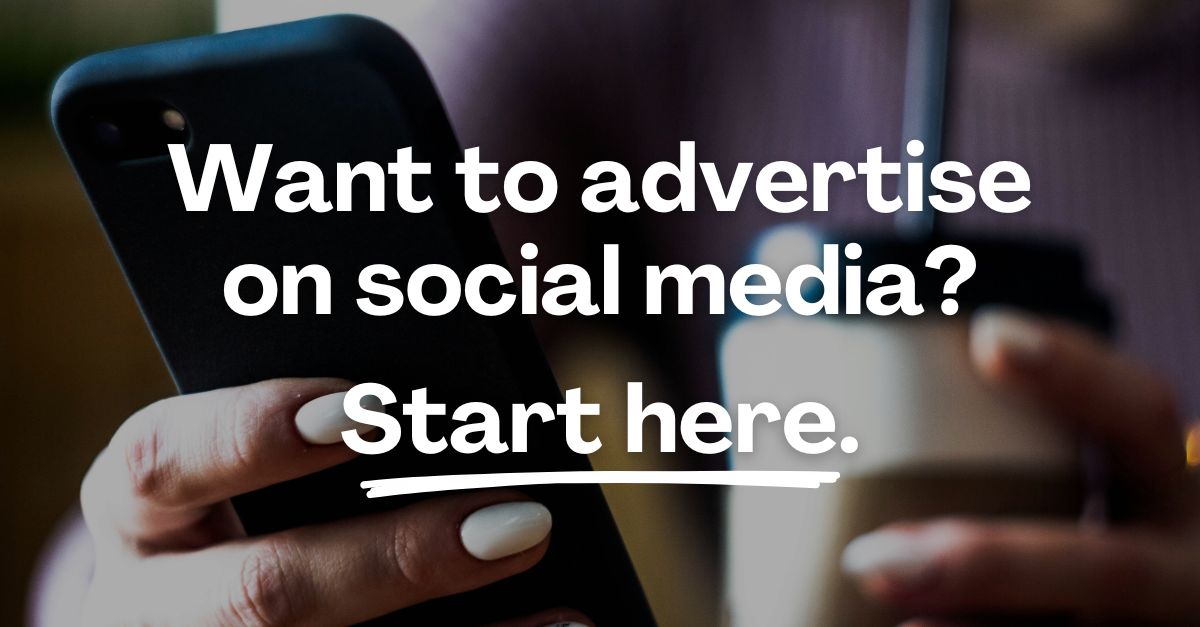
Social media isn’t just a platform for connecting with friends—it’s a powerful tool that can transform the reach and impact of your non-profit organization (NPO).
For non-profits operating on tight budgets, the thought of investing in paid advertising might seem daunting. However, with the right strategy, social media ads can be a game-changer, helping you increase visibility, drive traffic to your website, and attract new supporters who are passionate about your cause.
In this blog post, we’ll delve into the essentials of social media advertising for non-profits, from selecting the right platform, to crafting compelling content, and tracking your campaign’s success.
Whether you’re new to social media ads or looking to refine your strategy, our guide will equip you with the knowledge and tools needed to amplify your mission and make a lasting impact.
Why is Paid Advertising Important for Non-Profits?
For non-profits, organic reach on social media is often limited due to the crowded nature of these platforms and their ever-changing algorithms.
Paid advertising breaks through these barriers, giving you control over who sees your message. This is especially crucial when you have a specific goal, such as driving donations, increasing event attendance, or raising awareness for a campaign.
By investing in paid ads, your non-profit can benefit from:
1. Enhanced Targeting Capabilities
Unlike organic posts that reach a broad and often random audience, paid ads allow you to target specific demographics, interests, behaviors, and even locations. This ensures that your message is delivered to people who are more likely to take action, whether that’s donating, signing up for a newsletter, or attending an event.
2. Scalability
Paid social media campaigns can be scaled up or down based on your budget. This flexibility means you can start small, test what works, and gradually increase your investment as you see results. Even with a modest budget, you can achieve significant impact by strategically allocating funds to your highest-performing campaigns.
3. Measurable Results
One of the key advantages of paid social media advertising is the ability to track and measure the effectiveness of your campaigns in real-time. Platforms like Facebook and Instagram provide detailed analytics that show how your ads are performing, from click-through rates to conversion metrics. This data-driven approach allows you to make informed decisions and adjust your strategy to optimize results.
How Does Paid Social Media Advertising Work?
To effectively run a paid social media campaign, you need to understand the three key components that make up the structure of your advertisements: the Campaign, the Ad Group, and the Ads themselves. Each component plays a critical role in defining your strategy, organizing your efforts, and ensuring that your message reaches the right audience. Here’s how these components work together:
1. Campaign Level: Setting the Foundation
The Campaign level is where you establish the overall goals and parameters for your advertising efforts. This is the first step in creating your ads, and it sets the direction for everything that follows.
The campaign level begins with choosing your objective, which could be anything from increasing brand awareness to driving traffic, generating leads, or encouraging donations. Your chosen objective will guide the setup of your entire campaign.
For example, these are the choices to select from on Facebook (August 2024):
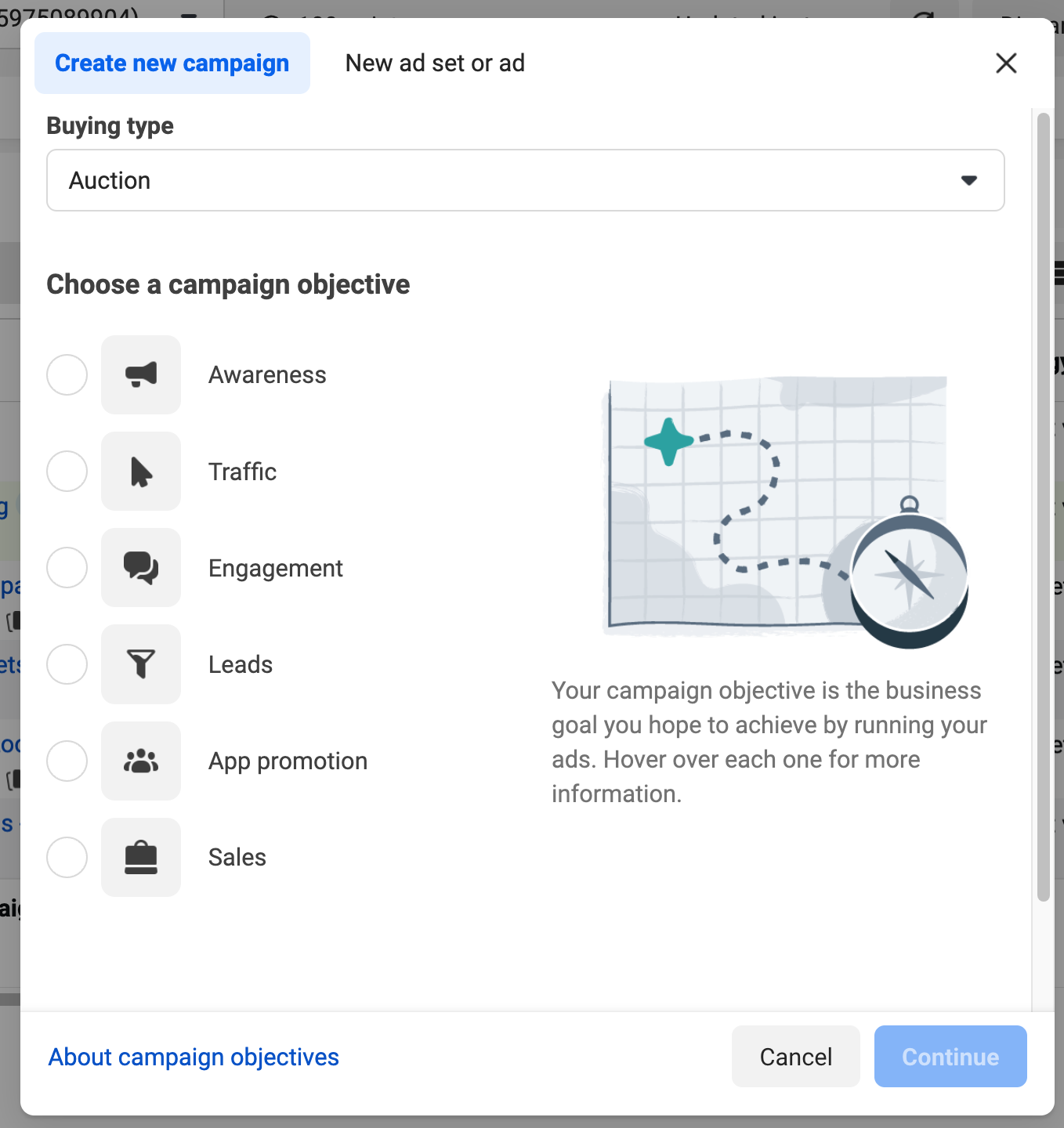
All major platforms look relatively similar. For example this is TikTok’s campaign set up selection:
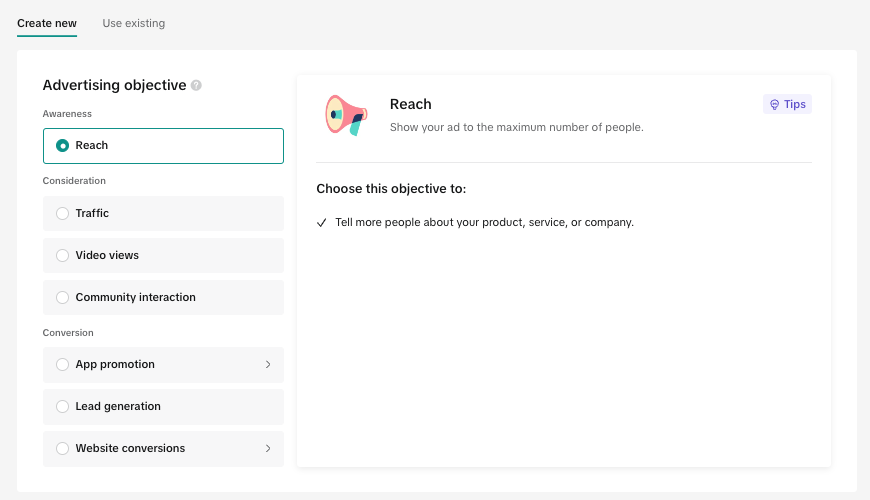
The structure of TikTok’s ad campaign setup is actually quite smart because it’s designed to align with the buyer’s journey, making it easier for advertisers to tailor their campaigns to specific stages of customer engagement.
This structured approach categorizes campaign objectives into three main phases: Awareness, Consideration, and Conversion. Each phase corresponds to a different stage of the buyer’s journey, allowing marketers to choose objectives that best align with their goals for reaching potential customers.
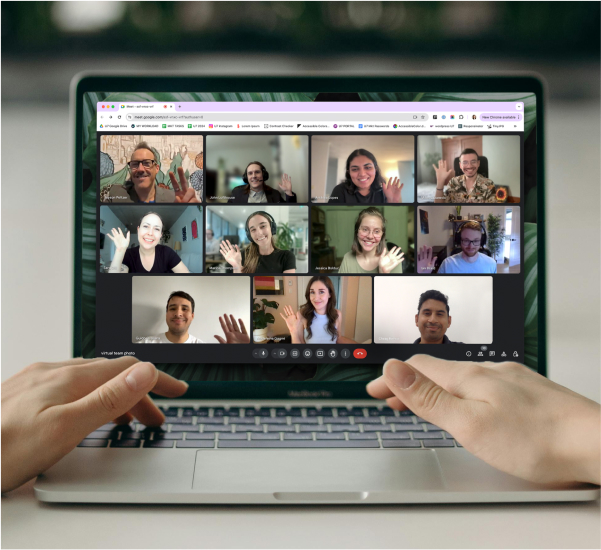
Boost your online presence with our help
- Web design and development
- SEO and PPC
- Social media strategy
- AI technology
1. Awareness
At the top of the funnel, the goal is to increase visibility and reach a broad audience. The “Reach” objective in the Awareness stage is ideal for campaigns aimed at introducing your non-profit to as many people as possible. This stage is about maximizing exposure and building brand recognition.
2. Consideration
This middle stage targets users who are already aware of your organization but need more information before deciding to engage further. TikTok offers objectives like “Traffic,” “Video views,” and “Community interaction” under Consideration. These options are designed to drive engagement by encouraging users to visit your website, watch videos, or interact with your content, thereby deepening their connection with your brand.
3. Conversion
The final stage is where you encourage users to take specific actions, such as signing up, making a donation, or purchasing a product. Conversion objectives like “App promotion,” “Lead generation,” and “Website conversions” are tailored to turn interested users into active supporters or customers. This stage is crucial for driving tangible results and achieving the ultimate goals of your campaign.
By structuring the ad campaign setup around the buyer’s journey, TikTok allows advertisers to strategically guide potential supporters from the initial awareness of their organization all the way to conversion. This methodical approach ensures that each campaign is targeted and relevant, maximizing the effectiveness of your ad spend.
2. Ad Group Level: Organizing and Targeting
Once you’ve set your campaign settings, the next step involves configuring the ad group level (referred to as an ad set on Facebook). This is where you refine and define the more granular settings that determine how your ads will be delivered to your target audience. The ad group level is crucial for tailoring your campaign to achieve the best possible results.
Here’s a breakdown of the key configurations you’ll need to set up at the ad group level across these platforms:
1. Audience Targeting
- Demographics: Define your audience based on factors such as age, gender, education, and language. This step allows you to narrow down who will see your ads based on key demographic data relevant to your campaign.
- Geographic Location: Choose the specific locations where you want your ads to appear. You can target broad areas like entire countries or more focused regions like cities or even specific postal codes.
- Interests and Behaviors: Platforms typically offer options to target users based on their interests, activities, and behaviors. For example, you can target users interested in specific industries, who engage with certain types of content, or who have recently taken a particular action, like making a purchase or signing up for a service.
- Custom Audiences: Some platforms allow you to create custom audiences by uploading your own data, such as email lists, or by targeting users who have interacted with your website or app. This option is powerful for retargeting purposes.
2. Ad Placements
- Automatic Placements: Most platforms provide an option to automatically place your ads across all available locations, such as feeds, stories, and search results.
- Manual Placements: If you want more control, you can manually select where your ads will appear. Depending on the platform, placements might include:
- Feed Ads: Appear in the main newsfeed on platforms like Facebook, LinkedIn, and TikTok.
- Stories Ads: Short, full-screen ads that appear between users’ stories on platforms like Instagram and Facebook.
- In-Stream Videos: Ads that play during video content, available on platforms like Facebook and TikTok.
- Search Ads: Ads that appear in search results, relevant on platforms like TikTok.
3. Budget & Schedule
- Budgeting Options: Choose whether you want to allocate a daily budget (a specific amount you want to spend each day) or a lifetime budget (a total amount you want to spend over the course of the campaign).
- Schedule: Set a start and end date for your ad group, or opt to run your ads continuously. On some platforms, you can also set specific times of day or days of the week when your ads should run, helping you target audiences when they’re most active.
- Bid Strategy: Platforms offer various bidding strategies, such as automatic bidding where the platform aims to get the most results for your budget, or manual bidding where you set a specific bid amount per action (like a click or conversion).
4. Ad Delivery Optimization
- Optimization Goal: Choose what you want the platform to optimize for—this could be clicks, impressions, conversions, or engagement, depending on your campaign goals. For instance, if your goal is to drive traffic to your website, you would optimize for link clicks.
- Cost Control: Set a target cost per result if you are using manual bidding. This allows you to manage how much you’re willing to pay for each conversion, click, or impression.
- Delivery Type: Decide whether you want your ads to be delivered evenly throughout the day (standard delivery) or as quickly as possible (accelerated delivery).
5. Conversion Tracking
- Tracking Pixels/Tags: Implement tracking pixels or tags on your website to monitor conversions, track the effectiveness of your ads, and optimize performance. Most platforms, like LinkedIn, TikTok, and Facebook, offer their own tracking codes that you can install on your website.
- Custom Conversions: Set up custom conversion events to track specific actions on your website, such as sign-ups, purchases, or downloads. These metrics help measure the ROI of your campaigns.
3. Ad Level: Crafting Your Message
The final component is the Ad level, where you create the actual advertisements that will be shown to your audience.
- Ad Content: This is where you upload your creatives—images, videos, or carousels—depending on what you’ve chosen at the Ad Group level.
- Headlines and URLs: You’ll add the headlines, text, and any associated URLs for your ads here. For example, in a follower campaign, the ad will automatically direct users to your social media account, whereas in other campaigns, you might link to a specific landing page or donation form.
- Customization: At this stage, you can also customize your ad copy to align with your campaign goals, whether it’s encouraging users to click, donate, sign up, or simply follow your organization.
Tips for planning your advertisements
Creating a successful social media ad campaign involves two key phases: Planning and Implementation. The Planning phase is critical for laying a strong foundation, while the Implementation phase brings your strategy to life. Below is a breakdown of these phases and key steps to help your non-profit achieve its goals.
Phase 1: Planning
This phase is all about setting clear objectives, understanding your audience, and developing a detailed campaign strategy. It’s the most time-consuming but also the most important part of the process, as it determines the overall effectiveness of your campaign.
1. Identify your objectives and key performance indicators
The foundation of any successful social media advertising campaign is a clear understanding of your objectives. What do you want to achieve? Whether it’s increasing volunteer sign-ups, driving donations, or boosting event attendance, defining your goals upfront is crucial.
Once your objectives are set, determine the key drivers that will help you reach them. These might include enhancing your website’s sign-up forms, creating compelling content, or launching targeted ad campaigns.
Then, set the KPIs. KPIs are the metrics that will measure the success of your campaign. Examples include click-through rates (CTR), conversion rates, or the number of sign-ups. Selecting the right KPIs will allow you to gauge the effectiveness of your ads and make informed decisions.
💡TIP: Read our blog post on Choosing and Tracking the Right KPIs for your Non-Profit for simple and easy to understand elements to guide you in identifying KPIs effectively.
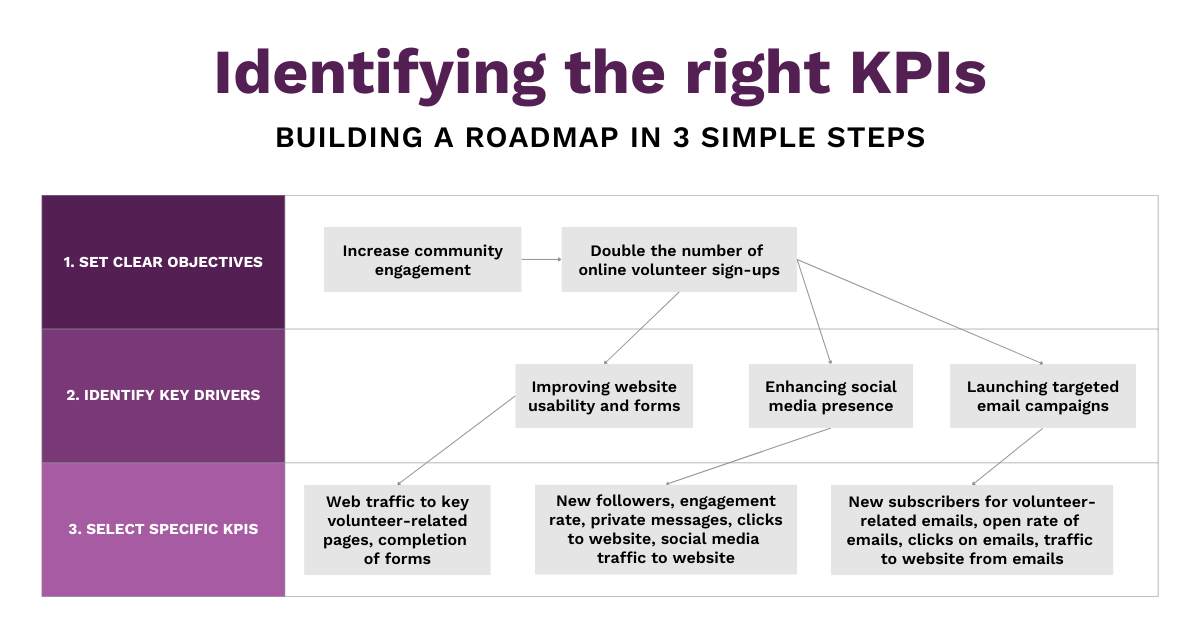
Practical Example:
- Objective: Double the number of volunteers aged 18-35 signing up in Ontario within the next year.
- Key Drivers: Improve website sign-up forms, launch targeted ads.
- KPIs: Track the number of clicks from social media ads to the completion rates of the online volunteer sign-up form.
2. Understand your audience and where they hang out
Before creating your ads, it’s essential to understand who your audience is and where they spend their time online.
Different platforms cater to different demographics, and using this knowledge can significantly improve your campaign’s effectiveness.
To reach your audience effectively, it’s important to choose the relevant social media platforms and content.
Where to Find Audience Insights
To gain a deep understanding of your audience, start by analyzing data from various sources:
- Google Analytics: Provides detailed insights into the demographics, interests, and behaviors of users who visit your website. This information can help you understand who is already engaging with your content online.
- Social Media Account Analytics: Each social media platform offers its own analytics dashboard (e.g., Facebook Insights, Instagram Insights) where you can see data about your followers, such as their age, gender, location, and engagement patterns.
- Social Media Scheduling Tools: Tools like Sprout Social, Later, and Hootsuite not only help you manage your posts but also offer analytics features that provide valuable audience insights.
- All-in-One Tools: Consider using an all-in-one tool like Metricool, which consolidates data from multiple social media platforms and paid ad campaigns, giving you a comprehensive view of your audience across different channels.
Select the Right Social Media Platforms for Your Campaign
Now that you have a better understanding of your audience, it’s time to choose the right platforms for your social media advertising campaign. Each platform has its own unique advantages and audience, so selecting the right one is crucial for maximizing your campaign’s impact. Here’s an overview of the main platforms:
- Facebook: A versatile platform with a broad user base, ideal for reaching various demographics, especially those aged 30-60. Its advanced targeting capabilities and robust ad formats make it a staple for many campaigns.
- Instagram: Best for visually-driven campaigns, particularly among younger audiences (18-35). Instagram’s features like Stories and Reels are perfect for engaging this demographic with short, compelling content.
- LinkedIn: The go-to platform for professional networking, making it ideal for campaigns targeting professionals, corporate sponsors, or volunteers in the 30-50 age range.
- Pinterest: A platform predominantly used by women, Pinterest is excellent for visual content and is particularly effective for reaching users aged 25-54. It’s a great choice for non-profits with visually appealing content, like DIY projects, infographics, or inspirational stories.
- TikTok: With a rapidly growing user base, TikTok is highly effective for reaching younger audiences (18-29) through short, engaging videos. This platform is ideal for campaigns that rely on creative, viral content.
- Snapchat: Another platform popular among younger audiences, Snapchat is best for quick, impactful messages and creative, interactive ads.
Consider these statistics from Sprout Social to better align your campaigns:
- 18-29 years: Snapchat (41%), TikTok (35%), Instagram (32%)
- 30-39 years: LinkedIn (34%), X/Twitter (34%), Snapchat (33%), Instagram (32%)
- 40-49 years: LinkedIn (25%), Facebook (22%), X/Twitter (21%)
- 50-59 years: Facebook (29%), LinkedIn (24%), Pinterest (24%)
Practical Example: If your goal is to attract volunteers aged 18-35, Instagram and TikTok would be strategic choices.
💡Case Study Tip: During a campaign for a client, aimed at recruiting unionized construction workers from marginalized groups (youth, women, newcomers), we discovered that content targeting youth performed unexpectedly well on LinkedIn—despite initial assumptions that it might not resonate. This underscores the importance of testing your content across platforms, as assumptions don’t always hold true. Testing can be costly, but it’s often worth the investment to gain accurate insights.
3. Prepare the campaign and ad group strategy
In this step, focus on structuring your campaign and ad groups. This involves deciding on the campaign’s location targeting, audience segmentation, budget allocation, and timelines.
- Campaign Structure: At the campaign level, set your overall budget, location targeting, and define your main objectives. For instance, if you’re running a regional campaign, you would specify the location at this level.
- Ad Group Strategy: Within each campaign, create ad groups that target specific audience segments. For example, you might create separate ad groups for different demographics or interest groups. On LinkedIn, remember that each ad group must be associated with a specific ad format, like carousel, video, or image.
- Budget and Timelines: Plan your budget allocation across platforms and ad groups. Some platforms, like TikTok, require a minimum daily budget (e.g., $50/day), which should be considered when allocating your spend. If you’re new to a platform, start with a smaller budget to test effectiveness before scaling up.
Practical Example: In a campaign for a client, we structured our LinkedIn ad groups by audience type (e.g., youth, women, newcomers) and allocated a $75,000 budget across multiple regions over 30 days. Each ad group had tailored landing pages, and we adjusted budgets based on each platform’s expected impact.
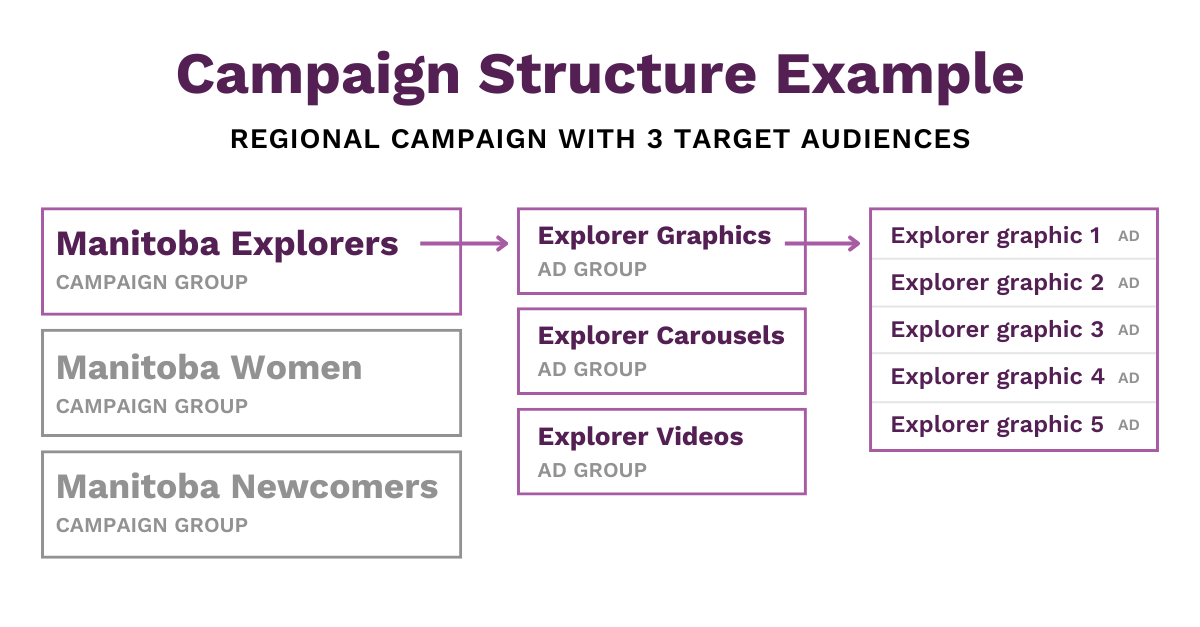
4. Create your assets
Your assets are the key to capturing your audience’s attention and effectively conveying your message. Whether it’s eye-catching visuals or compelling copy, the quality and relevance of your assets will directly impact the success of your social media ad campaign.
Consider Asset Production as Part of Planning
Whether you’re sourcing stock footage, creating custom content, or editing assets for different platforms, it’s crucial to allocate the necessary time and resources. This process may involve different team members or agencies, depending on the specific skills required. Balancing quality with budget is also key; for instance, high-end visuals may be more suitable for LinkedIn, while authentic, lower-budget content could resonate better on Instagram or TikTok.
Creating this visuals
Creating compelling visuals is a crucial part of your social media ad campaign, as they capture your audience’s attention and communicate your message effectively.
Start by taking inventory of the content you already have. Repurposing existing photos, videos, or graphics from previous campaigns can save time and resources, while still resonating with your current audience. If you don’t have enough suitable content on hand, consider using high-quality stock images or videos. Platforms like Unsplash, Pexels, and Shutterstock offer a wide range of visuals that can be customized to fit your campaign’s needs.
However, the most impactful visuals are often those that are custom-made to align closely with your campaign’s message and your brand. Custom content doesn’t have to be high-budget or professionally produced to be effective. In fact, on platforms like Instagram Reels, Stories, and TikTok, authenticity often resonates more with audiences than polished, high-production visuals. Partnering with influencers who can create relatable, low-budget style videos is another strategy that can help your content connect with your target audience on a personal level.
Crafting compelling copy
Crafting effective copy is a crucial element of your social media ad campaign. The style and tone of your messaging should align with your campaign’s objectives and the platform on which it will appear. Whether you aim to drive action, raise awareness, or simply engage your audience, your copy should resonate with your target audience. For example, on LinkedIn, a more professional tone may be appropriate, while on platforms like TikTok, a casual and engaging approach might work better. The copy might be direct and action-oriented, or it could aim to evoke emotion or build brand awareness, like Nike’s “Dream Crazy” campaign, which focused on inspiring people to pursue their passions. By adapting your copy to both your objectives and the platform, you can create more impactful and relevant messaging.
Consider incorporating storytelling elements
Incorporating storytelling elements into both your visuals and captions can significantly enhance the effectiveness of your social media ads. Storytelling is a powerful tool that makes your content more relatable and memorable by building an emotional connection with your audience. Whether through visuals or text, use narratives that align with your campaign’s goals, such as showcasing the journey of someone your organization has helped or highlighting the broader impact of your initiatives. By weaving these stories into your visuals and captions, you not only convey your message more compellingly but also engage your audience on a deeper, more personal level. For more insights on storytelling, consider exploring resources like this one that focus on how to craft compelling narratives for non-profits.
Asset review process
Once your assets are produced, a thorough review is necessary. To streamline this process, we recommend using a spreadsheet or a tool like Notion to organize your content. For instance, in the example below, we’ve created a spreadsheet for the review process where each visual is paired with its corresponding caption. We’ve written different captions tailored for various platforms, allowing for platform-specific messaging. A spreadsheet like this makes it easy for multiple team members to participate in the review process, as everyone can access the content, leave comments, and track edits within a shared, organized thread. This collaborative approach ensures that all feedback is captured and integrated before the final assets are approved, leading to a more polished and cohesive campaign.
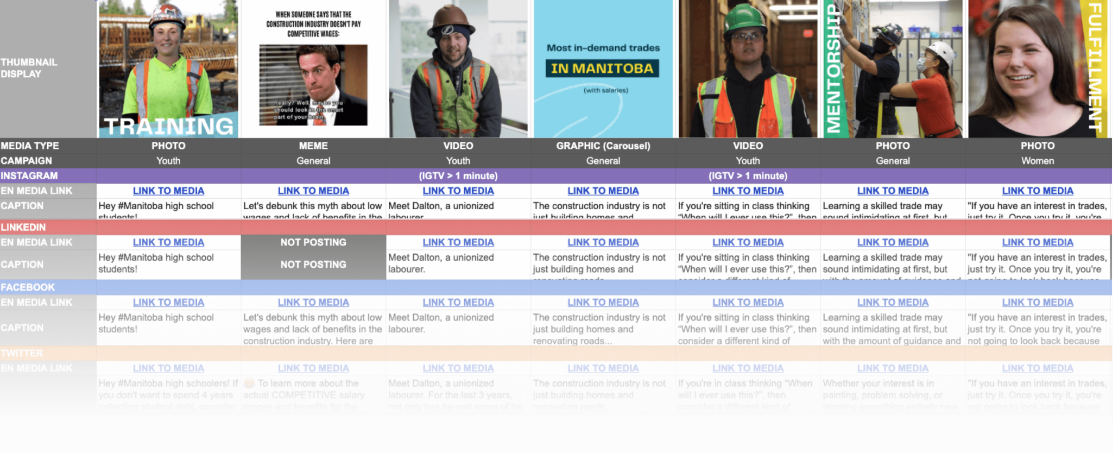
Phase 2: Implementation
With your strategy and assets in place, the Implementation phase is where you execute your campaign, and monitor performance to ensure success.
5. Set up the campaigns
Most social media platforms offer step-by-step guidance when creating a new campaign, along with online support and tutorial videos to assist first-time users. Leveraging these resources ensures you can effectively set up and manage your ad campaigns.
Here is a short list of Ad Managers for Social Media:
- Meta Ad Manager for Facebook and Instagram
- Youtube Ad Manager
- TikTok Ad Manager
- SnapChat Ad Manager
- LinkedIn Campain Manager
💡Tip : Most ad platforms allow you to duplicate campaigns and ad groups easily. This feature is helpful if you need to replicate a campaign structure across different regions or audience segments. Using this feature can save time and ensure consistency across your campaigns. Once you copy or duplicate, you can edit assets and landing pages as you wish to adjust further.
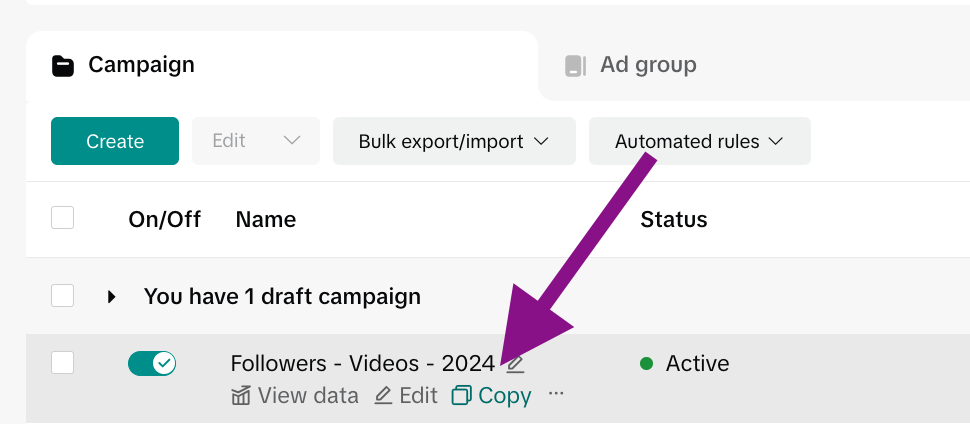
6. Track, analyze and adjust your campaign
To maximize the effectiveness of your social media ad campaigns, it’s important to leverage the right tools for tracking, analyzing, and optimizing performance. Here’s how you can use platform analytics, centralized dashboards, advanced reporting, and A/B testing to stay on top of your campaign’s impact.
- Social platform analytics: Each social media platform offers its own analytics tools—like Facebook Insights or Twitter Analytics—which are great starting points for evaluating the impact of your ads. However, reviewing data across multiple platforms can become tedious and time-consuming when managing campaigns on several channels.
- Centralized Analytics: This is where tools like Metricool come in handy. Metricool allows you to centralize data from various ad platforms into a single dashboard, making it easier to monitor your campaign’s overall performance at a glance. With everything in one place, you can quickly identify trends, compare platform performances, and make informed decisions about where to allocate your budget.
- Advanced Reporting with Looker Studio: For a deeper analysis, reporting tools like Looker Studio (formerly Google Data Studio) offer powerful capabilities to combine data from different sources. By integrating data from your ad platforms, Google Analytics, and UTM codes, Looker Studio enables you to track not only the effectiveness of your ads on the platforms themselves but also how users interact with your site after clicking on your ads. This holistic view of the user journey allows you to measure the true impact of your campaigns and make data-driven adjustments as needed.
- Optimize with A/B Testing: One effective way to fine-tune your campaigns is through A/B testing. This involves creating two variations of an ad to see which one resonates better with your audience. By comparing the results—such as click-through rates, conversions, and engagement—you can identify the most effective elements and apply these insights to future campaigns.
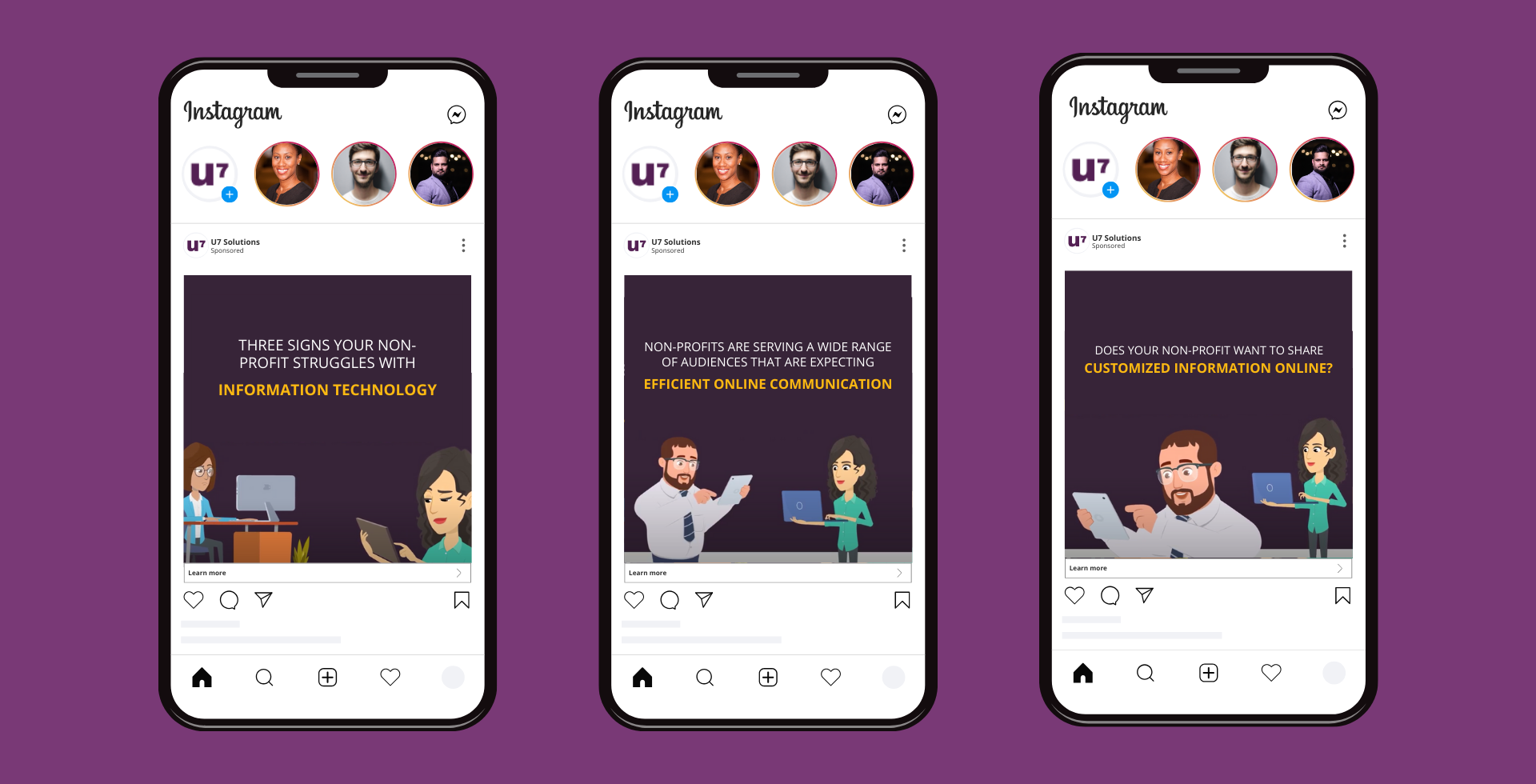
The Impact of Paid Social Media Advertising on Your Mission
Paid social media advertising is more than just a marketing tactic; it’s a strategic investment in your non-profit’s future. By leveraging these tools effectively, you can significantly increase your organization’s visibility, attract new supporters, and drive tangible outcomes that support your mission. Whether your goal is to raise awareness, recruit volunteers, or secure donations, paid ads provide a powerful means to connect with the people who matter most to your cause.
Additional Resources
To further enhance your social media advertising efforts, explore additional resources such as Facebook for Nonprofits, Google for Nonprofits, and The Nonprofit Marketing Guide. These platforms offer a wealth of tools, tips, and case studies to help you maximize your impact. Additionally, consider subscribing to industry blogs and attending webinars to stay informed about the latest trends and strategies in digital marketing for non-profits.
Reach out to us at U7 Solutions to discuss your next successful social media advertisement campaign. Together, we can amplify your message and achieve your goals.
Let's chat about your goals
OR tell us more about you
Swipe up for expert help!
